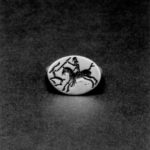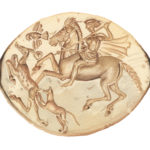by Adrienne Mayor (Regular Contributor)
How long have women participated in the ancient nomad practice of eagle falconry? The question arose in fall 2016, with the release of “The Eagle Huntress,” a documentary film about a teenage Kazakh horsewoman training a golden eagle to hunt in Mongolia.
A striking piece of archaeological evidence for nomad horsewomen hunting with trained eagles in antiquity came to light only recently.
The artifact is an exquisite ancient gold ring made in about 425 BC, displayed in Boston’s Museum of Fine Arts. The full significance of the hunting scene on the ring had eluded specialists’ understanding until a few years ago.
The ring shows a nomad horsewoman, identified in the museum text as an “Amazon.” Her hair and cloak are blown back, indicating the speed of the galloping horse. The woman carries a spear in her left hand and holds the reins in her right. The scene is so finely detailed that one can identify the species of deer–a spotted fallow buck with broad palmate antlers, common in Eurasia. The dog at her side is is a sight-hound similar to those used today by eagle hunters in Central Asia.
A large bird hovers in the top left above the deer. Art historians assumed the bird was merely a decoration. But in 2013, a series of spectacular photographs was published online and in international media, recording the victories of a young eagle huntress named Makpal Abdrazakova, who had been winning acclaim in eagle festivals and contests in Kazakhstan since 2010. Looking at these photographs of Makpal and other eagle huntresses and hunters led me to realize what was being depicted on the ancient gold ring. The bird above the fallow deer’s head is obviously an eagle with a hooked beak with spread wings and tail, about to attack the deer. The large bird was not random, as previously believed, but an integral part of the scene–it was the horsewoman’s other hunting companion, a trained golden eagle.
This naturalistic scene was identified as the earliest known image of a female eagle hunter in my book of 2014, The Amazons: Lives and Legends of Warrior Women across the Ancient World, with color plates 8 and 9, showing the ancient golden ring and Makpal Abdrazakova on her horse with her trained golden eagle in 2013.
The ring is compelling evidence that the unknown artist — perhaps not Greek but craftsman working in Anatolia or the Black Sea region — knew about or maybe even observed nomadic horsewomen of the steppes hunting game with trained eagles and sight-hounds.
A somewhat similar hunting scene but without a dog and eagle can be seen on a  bronze and silver alloy ring from the same date, late fifth century BC, in the Baltimore Walters Art Museum. That ring depicts a male hunter on horseback wearing a Scythian-style cap, brandishing a spear and chasing an antelope. The museum text suggests that the “ring belongs to a group made by local ‘barbarian’ Anatolian craftsmen in imitation of so-called Greco-Persian gems.”
bronze and silver alloy ring from the same date, late fifth century BC, in the Baltimore Walters Art Museum. That ring depicts a male hunter on horseback wearing a Scythian-style cap, brandishing a spear and chasing an antelope. The museum text suggests that the “ring belongs to a group made by local ‘barbarian’ Anatolian craftsmen in imitation of so-called Greco-Persian gems.”
For further information on the history of nomad women of the steppes participating in the ancient practice of eagle hunting and new generations of eagle huntresses, see https://web.stanford.edu/dept/HPS/EagleHuntress2016long.pdf
Adrienne Mayor is the author of The Poison King: Mithradates, Rome’s Deadliest Enemy, a nonfiction finalist for the 2009 National Book Award, and The Amazons: Lives and Legends of Warrior Women across the Ancient World (2014).

